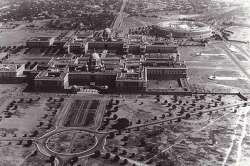Watch in pics: Delhi then and now
New Delhi: India's capital is a cosmopolitan city drawing people of all races and colours. The bustling metropolis has an amazing mix of modernization and carefully preserved antiquity. Sprawled over both sides of river Yamuna, it

New Delhi: India's capital is a cosmopolitan city drawing people of all races and colours. The bustling metropolis has an amazing mix of modernization and carefully preserved antiquity.
Sprawled over both sides of river Yamuna, it is one of the fastest growing cities in India.
New Delhi was built by a British architect Edward Lutyens in 1912 as the new capital of the British Raj.
The Victorian architecture now intermingles with the city's high rise buildings.
Concrete flyovers built to ease the growing traffic are interspersed with well laid gardens, Mughal tombs, forts and monuments.
The city traces its history to Mahabharata, the great epic tale of wars fought between estranged cousins, the Kauravas and the Pandavas for the city of Indraprastha.
Historically, the city has long since been the foremost in political importance with successive dynasties choosing it as their seat of power, between the 13th and the 17th centuries.
Old Delhi was founded by Mughal rulers who ruled the city in succession starting from Qutab-ub-din to Khiljis, Tughlaqs each, under a different name given to the city.
Delhi was made the capital of Independent India after independence and it was declared a National Capital Territory in 1992.
Since then, Delhi has changed tremendously in terms of architectural buildings, infrastructure, technological advancements, etc.
Let's have a look at what Delhi was then and how it has been transformed now.
Sprawled over both sides of river Yamuna, it is one of the fastest growing cities in India.
New Delhi was built by a British architect Edward Lutyens in 1912 as the new capital of the British Raj.
The Victorian architecture now intermingles with the city's high rise buildings.
Concrete flyovers built to ease the growing traffic are interspersed with well laid gardens, Mughal tombs, forts and monuments.
The city traces its history to Mahabharata, the great epic tale of wars fought between estranged cousins, the Kauravas and the Pandavas for the city of Indraprastha.
Historically, the city has long since been the foremost in political importance with successive dynasties choosing it as their seat of power, between the 13th and the 17th centuries.
Old Delhi was founded by Mughal rulers who ruled the city in succession starting from Qutab-ub-din to Khiljis, Tughlaqs each, under a different name given to the city.
Delhi was made the capital of Independent India after independence and it was declared a National Capital Territory in 1992.
Since then, Delhi has changed tremendously in terms of architectural buildings, infrastructure, technological advancements, etc.
Let's have a look at what Delhi was then and how it has been transformed now.